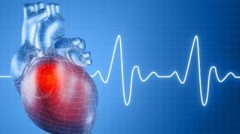LatinaLista — Last month was all about heart awareness. It might have had something to do with a day celebrating couples — something most singles without a significant other would rather ignore. But the fact is, no one, especially Latinas and Latinos, can afford to ignore heart disease — even if we think it can’t affect us.

It was a hard lesson to learn for my own family when one night last fall, my husband suddenly doubled over in pain just as he was getting ready for bed. Thinking he could “walk” off what he thought was indigestion, it became apparent too quickly that this wasn’t a reaction to eating spicy chili.
Rushing him to the local hospital, the staff soon informed me that my husband was in the throes of a full-blown heart attack. What made it worse was that the hospital staff revealed they weren’t equipped to handle my husband’s emergency. To make things even scarier, they told me that unless he was treated within the hour we could lose him.
The decision was to fly him by helicopter to a heart-specialty hospital downtown — asap. I wasn’t allowed to ride with him and so I jumped in the car and raced downtown. By the time I arrived at the hospital 30 minutes later, the procedure was done and the doctor was waiting for me, and the news wasn’t good.
My husband had such profound heart disease that he required five stents be put into his arteries. They could only put two that night and the doctor wanted him to rest for a couple of weeks before inserting the last three. He went on to tell me that if my husband had come into his office without having had a heart attack, he would have immediately conducted open heart surgery on him. Come to find out my husband’s heart disease is genetic and so that means my own children will have to watch their diets, exercise and do what they can so they don’t suffer the same thing as their dad.
Too often when reporting on the dismal statistics about heart disease among the Mexican American population — 30 percent of Mexican-American women and men have heart disease and one in four Latinos ages 35 and older with diabetes also has heart disease — I forget that my family and I are part of that at-risk population. It’s only when a life-and-death situation, like this, hits home do we even begin to realize just how uninformed we really are.
So, because spring is only a few week away, a time for rebirth, it’s fitting to talk about the one organ in the body that can give anyone either a new lease on life or extend the lease, if taken care of properly — but again, it’s all about having the information.
A program called Close the Gap from Boston Scientific is conducting such an information campaign about heart disease. Dr. Rozo, a specialist in Invasive Cardiovascular Diseases with the Cardiology Specialists of Houston (CSH), answered a few questions I had about heart disease and what can be done to keep hearts healthy and lives longer.
In men, what is the most common symptom of a heart attack? In women? In children?
About every minute in the United States, a woman dies of heart disease. It is important to know that not all heart attacks are sudden and intense; most heart attacks start out slowly, with mild pain or discomfort.
As with men, for women the most common heart attack symptom is chest pain or discomfort. But women are somewhat more likely than men to experience signs and symptoms unrelated to chest pain, particularly shortness of breath, nausea/vomiting, and back or jaw pain.
According to the American Heart Association, here are some signs that a heart attack may be happening:
- Chest discomfort: Most heart attacks involve discomfort in the center of the chest that lasts more than a few minutes, or that goes away and comes back. It can feel like uncomfortable pressure, squeezing, fullness or pain.
- Discomfort in other areas of the upper body: Symptoms can include pain or discomfort in one or both arms, the back, jaw or stomach.
- Shortness of breath: Often without chest pain of any kind.
- Other signs of discomfort: Cold sweats, nausea/vomiting, lightheadedness or dizziness or unusual fatigue.
What should people do to help someone who is having a heart attack?
If you ever suspect that you or someone you know is having one or more of these symptoms, don’t wait more than a few minutes to call for help. Call 9-1-1 for the fastest way to receive lifesaving treatment.
What preventive measures can be taken to keep the heart strong?
You must take charge of your heart health and the risk factors you can control. Some things to consider include:
• Don’t smoke and avoid secondhand smoke. People who smoke are up to six times more likely to suffer a heart attack than non-smokers. If you smoke, QUIT.
• Aim for a healthy weight: If you don’t know your ideal weight, ask your doctor. The more overweight you are the higher your risk for heart disease.
• Get moving: Make a commitment to be more physically active. Every day, aim for 30 minutes of moderate-intensity activity such as taking a brisk walk, raking, dancing, light weight lifting, house cleaning or gardening.
• Eat for heart health: choose a diet low in saturated fat, trans fat, sodium and cholesterol. Be sure to include whole grains, vegetables and fruits.
• Know your numbers: ask your doctor to check your blood pressure, cholesterol (total, HDL, LDL, and triglycerides) and blood glucose. Work with your doctor to improve any numbers that are not normal.
How much does exercise play in keeping a heart healthy?
Physical activity is crucial to general health. It helps people maintain a healthy weight and reduces stress levels. But more than that, exercise directly targets primary aspects of heart health: cholesterol, triglycerides and blood pressure.
The form of exercise most often connected with decreasing heart disease is aerobic exercise. That’s exercise that raises your heart rate, like jogging, swimming, jumping rope or bike riding. Aerobic exercise can decrease the risk of heart disease by 20 to 60 percent, depending on the exertion level, duration and frequency.
Part of the benefit has to do with the fact that aerobic exercise lowers blood pressure, a major component in determining the risk of heart disease. The more pressure blood exerts on artery walls, the harder it is for your heart to pump efficiently. Any time you get your heart pumping harder, like when you go for a run or even a fast walk, your heart muscle gets exercise. It needs to pump up to 10 times more blood to a muscle group that’s exercising than to one at rest [source: MSNBC]. And like your biceps, the heart muscle gets stronger from repeated exertions. A stronger heart has an easier time pumping blood, so it can relax more. With relaxation, arteries expand, creating more room for blood to flow.
Exercise also affects both blood pressure and coronary artery disease because it affects triglyceride levels and cholesterol levels. Triglycerides, like cholesterol, are fatty substances that travel through our blood to our cells.
High triglyceride and LDL cholesterol levels make it more likely that fats will build up on artery walls, raising blood pressure and restricting blood flow. HDL cholesterol, or “good cholesterol,” has the opposite effect: It prevents fatty buildup on artery walls.
Studies show conclusively that exercise lowers triglyceride levels and raises levels of HDL (good) cholesterol. Exercise also seems to decrease the amount of LDL (bad) cholesterol in the body, although those results are more mixed.
What kinds of exercises should people, who are not accustomed to exercising, do to stave off a heart attack?
Just how much exercise you need in order to help your heart varies. Overall, a good guideline is 30 minutes of aerobic exercise every day, although three days a week will also provide significant benefits. Research has shown that resistance exercise (like weight training) also improves heart health, although somewhat less than aerobic activity.
While in most cases, more exercise is better, it also increases the risk of injury, so overdoing it is a bad idea. People with medical conditions, people on medication and senior citizens should always consult a doctor before starting an exercise program to make sure they’re healthy enough to handle the heart and body strain.
But perhaps the most important thing to keep in mind is that any exercise is better than no exercise. Although moderate-to-vigorous aerobic exercise is best, low-strain activities like yard work and playing golf regularly will also help your heart. You needn’t run marathons to reduce your risk of heart attack. If you just get up and move around more, your heart will be better off.
What kinds of foods should Latinos avoid if wanting to have a healthy heart?
Overall, this is a simple solution for all people regardless of race. Eating less fat decrease the chances of developing clogged arteries. At its simplest, if there’s less fat in the body, there’s less fat available to build up on artery walls. Choosing a diet low in saturated fat, trans fat, sodium and cholesterol is a great place to start. It is also important to include whole grains, vegetables and fruit.
Since last month was Heart Awareness month and also known as the month of Valentine’s, is chocolate good or bad for the heart?
All chocolate is NOT created equal. Dark chocolate is definitely better for you than other forms of chocolate – but while a little dark chocolate is good, a lot is not better. Chocolate still is loaded with calories. Remember that a balanced diet — and plenty of exercise — is still the key to heart health.





Comment(1)
MarlenyWood
Hi Marisa, thank you for writing about this very critical issue within women and Latinos in general. It is important to continue to spread this message. The American Heart Association’s Go Red Por Tu Corazon bilingual movement focuses specifically on educating Latinas on their risks for heart disease and how to protect themselves and their families. Latinas, on average, are likely to get heart disease 10 years earlier than other women – it’s important that this message be spread to younger Latinas and their families.
http://www.GoRedCorazon.org There is also a facebook page: http://www.facebook.com/goredportucorazon